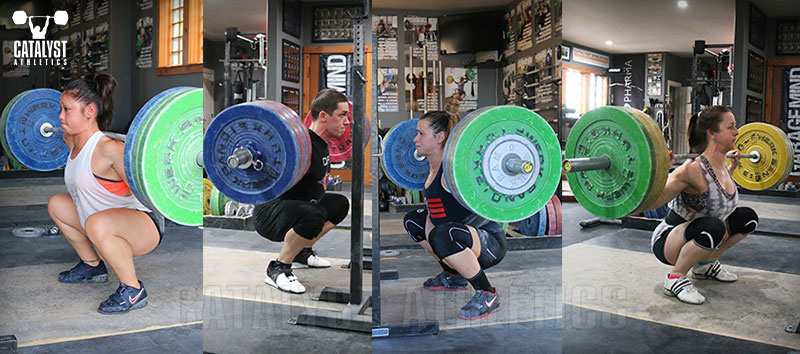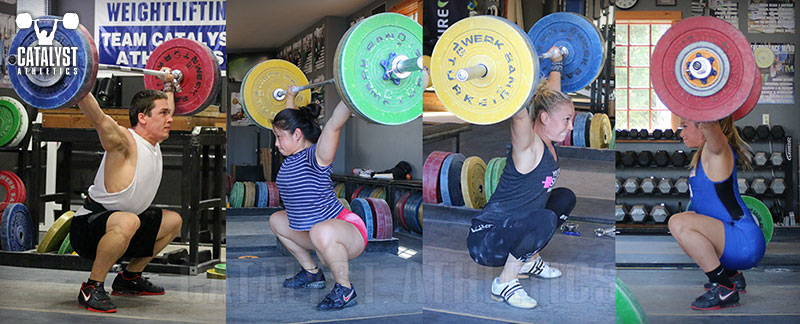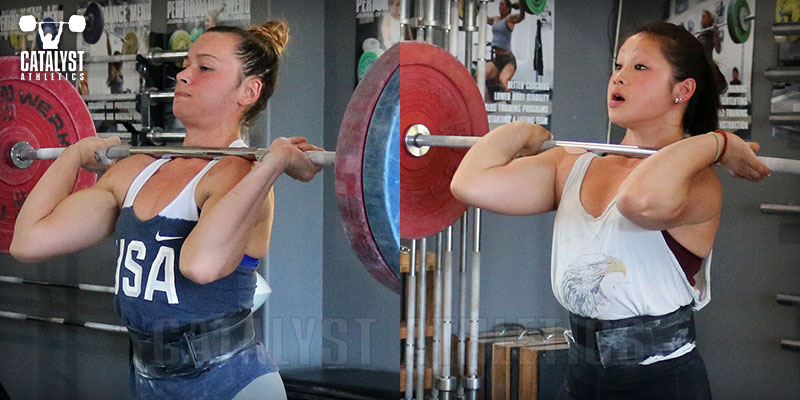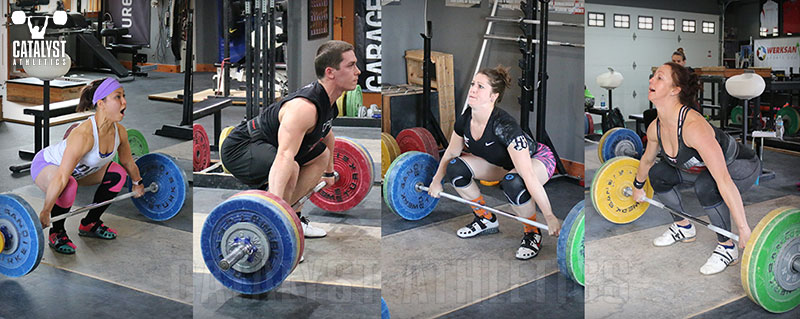Articles
Individual Variation in Weightlifting: Effects & Solutions
September 18 2017

September 18 2017

We all love simple, formulaic answers to our questions. It makes life easy to be told exactly how to do something with no equivocation. In weightlifting, we all want to know right now exactly what position to be in, exactly what our training programs should look like, exactly what lifts we can expect on a given date. I always feel a bit guilty when answering questions with “It depends”, “There’s a lot of variation” or “You’re going to have to experiment”, but in those cases, any other answer would be inaccurate or incomplete.
I want to break down a few specific common variations from the “ideal” weightlifter and explain what they will affect and what you can do to mitigate the downsides.
First, let’s establish what the “ideal” weightlifter is: Essentially we’re talking about an athlete with mesomorphic proportions—balanced in terms of trunk and limb length. Divergence from this ideal means either long limbs and short trunk, or long trunk and short limbs. Of course there are many variations within these three broad categories as well—a lifter with balanced leg and trunk proportions may have comparatively short arms, or a lifter may have an unusual disparity in the relative lengths of the upper and lower arm or leg. Any of these things can create difficulty in achieving the “standard” body positions or motions in relation to the barbell to degrees ranging from slight inconvenience to genuine impossibility.
The great thing for coaches about a national sports system is that they don’t have to deal with any lifters who haven’t been proven suitable for the sport—if you’re not set up well for the game, you don’t get to play. Everyone else has to find ways to lift or coach despite less than perfect proportions or other relevant physical traits. Some of us are never going to be great in this sport, but that doesn’t mean we don’t love it anyway, so we figure out ways to be as successful as possible with what we’ve got to work with.
Let’s also note here for the record that we’re talking about anatomical structure—not mobility limitations. The latter will of course dictate positions, but it can be changed, while the former cannot. It should also be mentioned that regardless of proportions, a lifter can get into the “wrong” position, e.g. a lifter with perfect proportions for the jerk rack position may still keep the bar on the fingertips and the elbows high when unnecessary.
The following are the typical results of the listed proportions. They will not be 100% accurate across the board, and in some cases can actually be the complete opposite (e.g. clean/jerk rack position).
Squat Bottom Position
Long Limbs/Short Trunk: Trunk inclined forward more; hips farther back and/or lower; knees farther forward over toes; knees oriented outward more.
Short Limbs/Long Trunk: Trunk more upright; hips higher and/or closer (horizontally) to feet; knees farther back relative to toes; knees oriented more forward.
Hip Anatomy: Depending on the actual structure of the hips, the legs will have to be oriented more or less outward to maximize mobility. It’s fairly common for women with long legs to feel more comfortable with feet narrower and the knees more forward in the squat than their male counterparts with similar proportions.
Universal Points: Full depth means the knee joint closed as much as possible with the weight balanced across the full foot, foot flat on the floor, and the back extended. The thigh should be in line with the corresponding foot, i.e. the knee moves out in the same direction the toe is pointing.
Adjustments: The key with the squat is to determine the ideal foot position, which will then dictate the way the legs move in the hips to maximize mobility. Depth should be maximal for the individual, which means the knee joint closed as much as possible with the back arch preserved and the weight balanced over the foot. Ankle mobility increases in importance with longer legs to allow the knees to travel farther forward to bring the hips in to keep the trunk more upright. If possible with your hip anatomy, turning the feet out and allowing the knees to move outward more can also reduce the negative effects of long legs in the squat.

Shorter-legged squats on the left; longer-legged squats on the right
Snatch Receiving Position
Long Limbs/Short Trunk: Trunk inclined forward more; hips farther back and/or lower; knees farther forward over toes; knees oriented outward more; arms and trunk less in line; grip wider (and bar possibly closer to the head).
Short Limbs/Long Trunk: Trunk more upright; hips higher and/or closer (horizontally) to feet; knees farther back relative to toes; knees oriented more forward; arms and trunk more in line; grip narrower (and bar possibly higher above the head).
Universal Points: Same as for the squat bottom position, with an emphasis on maintaining as upright of a trunk allowed by your build. Grip width ideally places the bar in the crease of the hips when in the tall position, but should be adjusted if such a grip creates pain or stability problems overhead.
Adjustments: Grip width will be the biggest issue. In order for the bar to contact the body in the crease of the hip, sometimes extremely wide grip positions will be required for long-limbed lifters, which can place additional stress on the wrists and elbows, and reduce the structural integrity of the overhead position. Often a narrower grip will be necessary to avoid these problems. In order to make this work, some tricks to get the bar to interact better with the body will be needed, such as shrugging up and back in the second pull or slight arm bend. If a narrower grip can’t be used, additional focus on overhead strength and stability is a good idea.

Shorter-legged snatch receiving positions on the left; longer-legged snatch receiving positions on the right
Clean & Jerk Rack Position
Long Limbs/Short Trunk: Wider grip; bar more in fingertips than palm; elbows lower.
Short Limbs/Long Trunk: Narrower grip; bar deeper in hand; elbows higher.
Upper/Lower Arm Disparity: If the upper or lower arm is significantly longer than the other, the rack position can be extremely difficult because the lifter is unable to position the hand on the bar well. Usually this will mean lower elbows and/or having only the fingertips under the bar instead of a fuller grip. This is really what creates more variation in the rack position than relative limb/trunk lengths.
Universal Points: The shoulders should be pushed forward completely and up slightly; grip should be as full as possible around the bar; in the clean, the elbows should be high, while in the jerk, the elbows should be down and spread to the sides (they should remain at least slightly in front of the bar at the lowest). See this article for more rack position details.
Adjustments: Changing the grip width can minimize problems in the rack position, although not always to a significant degree. Typically going narrower for shorter arms and wider for longer arms will help, but experiment with both to find what works best. Mobility in the shoulders and upper back will be critical for optimizing the rack position as much as possible with your proportions.

Longer-limbed jerk rack position on the left; shorter-limbed jerk rack position on the right
Snatch & Clean Starting Position
Long Limbs/Short Trunk: Bar farther forward over foot; shins inclined forward more; trunk inclined forward more; hips lower relative to knees.
Short Limbs/Long Trunk: Bar farther back over foot; shins more upright; trunk more upright; hips higher relative to knees.
Hip Height: This is an interesting one because it can be all over the map, but is generally more dependent on total height than relative trunk/limb length. Shorter lifters will usually naturally be able to position the hips above the knees for a strong starting position, while taller lifters, in order to achieve an upright position, will need to place the hips lower—even with or even slightly below the hips. However, these taller lifters will often keep the hips above the knees and push the shoulders farther forward over the bar (i.e. lean the trunk over more) because it feels more comfortable.
Universal Points: The bar should start between over the middle of the toes to slightly in front of the middle of the foot depending on proportions; the shoulder joint should be directly above or slightly in front of the bar; the shins should be inclined forward to put the knees at least slightly over the bar.
Adjustments: Long-legged lifters will typically find some relief with a wider stance with the toes and knees oriented outward more, and if very tall overall, may need to start with the shoulders slightly farther in front of the bar to bring the hips up somewhat. Shorter-legged lifters may be able to start with the bar a little farther back over the foot than the balls of the foot as is the standard positioning.

Shorter-legged snatch starting positions on the left; longer-legged snatch starting positions on the right
The real point of all of this goes back to the beginning—it depends. Don’t look to match other lifters’ positions as an athlete or a coach. Instead, look to meet the universal criteria of each position and learn to recognize those points without being distracted by seemingly “wrong” positions.
I want to break down a few specific common variations from the “ideal” weightlifter and explain what they will affect and what you can do to mitigate the downsides.
First, let’s establish what the “ideal” weightlifter is: Essentially we’re talking about an athlete with mesomorphic proportions—balanced in terms of trunk and limb length. Divergence from this ideal means either long limbs and short trunk, or long trunk and short limbs. Of course there are many variations within these three broad categories as well—a lifter with balanced leg and trunk proportions may have comparatively short arms, or a lifter may have an unusual disparity in the relative lengths of the upper and lower arm or leg. Any of these things can create difficulty in achieving the “standard” body positions or motions in relation to the barbell to degrees ranging from slight inconvenience to genuine impossibility.
The great thing for coaches about a national sports system is that they don’t have to deal with any lifters who haven’t been proven suitable for the sport—if you’re not set up well for the game, you don’t get to play. Everyone else has to find ways to lift or coach despite less than perfect proportions or other relevant physical traits. Some of us are never going to be great in this sport, but that doesn’t mean we don’t love it anyway, so we figure out ways to be as successful as possible with what we’ve got to work with.
Let’s also note here for the record that we’re talking about anatomical structure—not mobility limitations. The latter will of course dictate positions, but it can be changed, while the former cannot. It should also be mentioned that regardless of proportions, a lifter can get into the “wrong” position, e.g. a lifter with perfect proportions for the jerk rack position may still keep the bar on the fingertips and the elbows high when unnecessary.
The following are the typical results of the listed proportions. They will not be 100% accurate across the board, and in some cases can actually be the complete opposite (e.g. clean/jerk rack position).
Squat Bottom Position
Long Limbs/Short Trunk: Trunk inclined forward more; hips farther back and/or lower; knees farther forward over toes; knees oriented outward more.
Short Limbs/Long Trunk: Trunk more upright; hips higher and/or closer (horizontally) to feet; knees farther back relative to toes; knees oriented more forward.
Hip Anatomy: Depending on the actual structure of the hips, the legs will have to be oriented more or less outward to maximize mobility. It’s fairly common for women with long legs to feel more comfortable with feet narrower and the knees more forward in the squat than their male counterparts with similar proportions.
Universal Points: Full depth means the knee joint closed as much as possible with the weight balanced across the full foot, foot flat on the floor, and the back extended. The thigh should be in line with the corresponding foot, i.e. the knee moves out in the same direction the toe is pointing.
Adjustments: The key with the squat is to determine the ideal foot position, which will then dictate the way the legs move in the hips to maximize mobility. Depth should be maximal for the individual, which means the knee joint closed as much as possible with the back arch preserved and the weight balanced over the foot. Ankle mobility increases in importance with longer legs to allow the knees to travel farther forward to bring the hips in to keep the trunk more upright. If possible with your hip anatomy, turning the feet out and allowing the knees to move outward more can also reduce the negative effects of long legs in the squat.

Shorter-legged squats on the left; longer-legged squats on the right
Snatch Receiving Position
Long Limbs/Short Trunk: Trunk inclined forward more; hips farther back and/or lower; knees farther forward over toes; knees oriented outward more; arms and trunk less in line; grip wider (and bar possibly closer to the head).
Short Limbs/Long Trunk: Trunk more upright; hips higher and/or closer (horizontally) to feet; knees farther back relative to toes; knees oriented more forward; arms and trunk more in line; grip narrower (and bar possibly higher above the head).
Universal Points: Same as for the squat bottom position, with an emphasis on maintaining as upright of a trunk allowed by your build. Grip width ideally places the bar in the crease of the hips when in the tall position, but should be adjusted if such a grip creates pain or stability problems overhead.
Adjustments: Grip width will be the biggest issue. In order for the bar to contact the body in the crease of the hip, sometimes extremely wide grip positions will be required for long-limbed lifters, which can place additional stress on the wrists and elbows, and reduce the structural integrity of the overhead position. Often a narrower grip will be necessary to avoid these problems. In order to make this work, some tricks to get the bar to interact better with the body will be needed, such as shrugging up and back in the second pull or slight arm bend. If a narrower grip can’t be used, additional focus on overhead strength and stability is a good idea.

Shorter-legged snatch receiving positions on the left; longer-legged snatch receiving positions on the right
Clean & Jerk Rack Position
Long Limbs/Short Trunk: Wider grip; bar more in fingertips than palm; elbows lower.
Short Limbs/Long Trunk: Narrower grip; bar deeper in hand; elbows higher.
Upper/Lower Arm Disparity: If the upper or lower arm is significantly longer than the other, the rack position can be extremely difficult because the lifter is unable to position the hand on the bar well. Usually this will mean lower elbows and/or having only the fingertips under the bar instead of a fuller grip. This is really what creates more variation in the rack position than relative limb/trunk lengths.
Universal Points: The shoulders should be pushed forward completely and up slightly; grip should be as full as possible around the bar; in the clean, the elbows should be high, while in the jerk, the elbows should be down and spread to the sides (they should remain at least slightly in front of the bar at the lowest). See this article for more rack position details.
Adjustments: Changing the grip width can minimize problems in the rack position, although not always to a significant degree. Typically going narrower for shorter arms and wider for longer arms will help, but experiment with both to find what works best. Mobility in the shoulders and upper back will be critical for optimizing the rack position as much as possible with your proportions.

Longer-limbed jerk rack position on the left; shorter-limbed jerk rack position on the right
Snatch & Clean Starting Position
Long Limbs/Short Trunk: Bar farther forward over foot; shins inclined forward more; trunk inclined forward more; hips lower relative to knees.
Short Limbs/Long Trunk: Bar farther back over foot; shins more upright; trunk more upright; hips higher relative to knees.
Hip Height: This is an interesting one because it can be all over the map, but is generally more dependent on total height than relative trunk/limb length. Shorter lifters will usually naturally be able to position the hips above the knees for a strong starting position, while taller lifters, in order to achieve an upright position, will need to place the hips lower—even with or even slightly below the hips. However, these taller lifters will often keep the hips above the knees and push the shoulders farther forward over the bar (i.e. lean the trunk over more) because it feels more comfortable.
Universal Points: The bar should start between over the middle of the toes to slightly in front of the middle of the foot depending on proportions; the shoulder joint should be directly above or slightly in front of the bar; the shins should be inclined forward to put the knees at least slightly over the bar.
Adjustments: Long-legged lifters will typically find some relief with a wider stance with the toes and knees oriented outward more, and if very tall overall, may need to start with the shoulders slightly farther in front of the bar to bring the hips up somewhat. Shorter-legged lifters may be able to start with the bar a little farther back over the foot than the balls of the foot as is the standard positioning.

Shorter-legged snatch starting positions on the left; longer-legged snatch starting positions on the right
The real point of all of this goes back to the beginning—it depends. Don’t look to match other lifters’ positions as an athlete or a coach. Instead, look to meet the universal criteria of each position and learn to recognize those points without being distracted by seemingly “wrong” positions.
